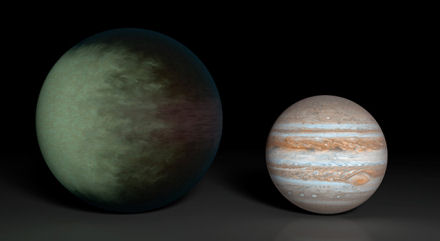
The discovery of exoplanet Kepler-16b is the first confirmed, unambiguous example of a circumbinary planet – a planet orbiting not one, but two stars (artist’s impression appears right). Despite having two suns, astronomers say the planet is quite cold – with a surface temperature of around minus 150& #176; Fahrenheit. It is similar to Saturn in both size and mass and it orbits its two parent stars every 229 days at a distance of 65 million miles (somewhat similar to Venus’ 225-day orbit).
About 200 light-years distant from Earth, Kepler-16b was detected via a planetary transit – where a star dims when a planet crosses in front of it. However, the planet’s discovery was complicated by the fact that the two stars in the system eclipse each other, causing the total brightness to dim periodically.
Astronomers noticed that the system’s brightness sometimes dipped even when the stars were not eclipsing one another, hinting at a third body. The additional dimming events reappeared at irregular time intervals, indicating that the stars were in different positions in their orbit each time the third body passed. This showed that this third body was circling, not just one, but both stars.
“Much of what we know about the sizes of stars comes from such eclipsing binary systems, and most of what we know about the size of planets comes from transits,” said planet co-discoverer Laurance Doyle, of the SETI Institute. “Kepler-16 combines the best of both worlds, with stellar eclipses and planetary transits in one system.”
Related:
No shortage of neo-Earths
New optics capture exoplanet 63 million light years distant
Newly discovered exoplanet may be habitable
Discoverer of alien bacteria says life probably exists “everywhere”








Comments are closed.